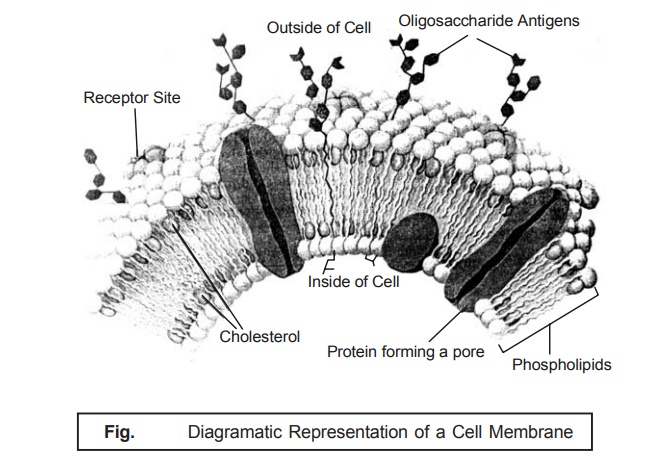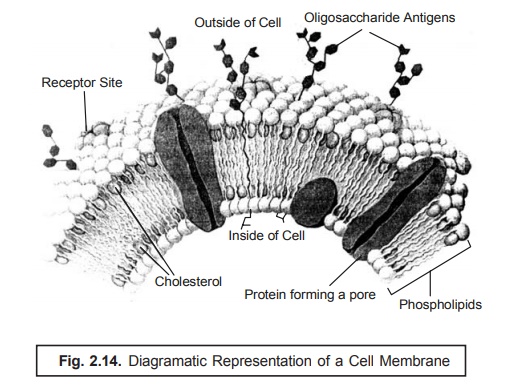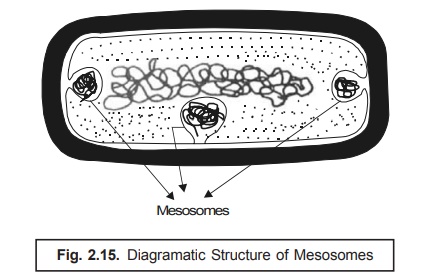The Cell Membrane
| Home | | Pharmaceutical Microbiology | | Pharmaceutical Microbiology |Chapter: Pharmaceutical Microbiology : Structure and Function of Bacterial Cells
Literally, ‘membrane’ designates a thin, soft, pliable layer of tissue that virtually lines a tube or cavity, covers an organ or structure, or separates one part from another specifically.

The Cell Membrane
Literally, ‘membrane’ designates a thin, soft, pliable layer of tissue that virtually lines a tube or cavity, covers an organ or structure, or separates one part from another specifically. The cell membrane refers to the very fine, soft, and pliable layer of tissue that essentially forms the outer boundary of a cell ; and it is made of phospholipids, protein, and cholesterol, with carbohydrates on the outer surface e.g., plasma membrane, as shown in Fig. : 2.14.

In other words, the cell membrane is the bounding layer of the cytoplasmic contents, and repre-sents the principal osmotic and permeability barrier. It is a lipoprotein (having a ratio of protein and lipid, 70 : 30), devoid of any polysaccharide, and on being examined via an electron microscope shows up with a distinct three-layer unit with a prominent unit membrane structure.
The actual thickness of the two outer layers are approximately 3.5 nm, and the middle layer is nearly 5 nm thick. The lipids observed in the cell membrane are largely phospholipids, for instance : phosphatidylethanol amine, and to a lesser extent phosphatidylserine and . The other three vital regions in the cell membrane are, namely :
(a) Polar head regions — of the phospholipids are strategically positioned at the two outer surfaces,
(b) Centre of membrane — contain the extended hydrophobic fatty acid chains, and
(c) Middle protein layer — is duly intercalated into the phospholipid bilayer.
Importance of Cell Membrane. The importance of the cell membrane lies in monitoring the three vital functions of immense utility to the cell, namely :
(1) It mostly acts as an ‘osmotic barrier’, and usually contains permeases that are solely respon-sible for the viable transport of nutrients and chemicals both in and outside the cell ;
(2) It essentially contains the enzymes that are intimately involved in the biosynthesis of membrane-lipids together with a host of other macromolecules belonging to the bacterial cell wall ; and
(3) It predominently comprises of the various components of the energy generation system.
It is, however, pertinent to state here that besides these critically important features there is an ample evidence to demonstrate and prove that the cell membrane has particular ‘attachment sites’ exclusively meant for the replication and segregation of the bacterial DNA and the plasmids.
Mesosomes. It has been duly observed that in certain instances of microorganisms, more specifi-cally and precisely in the Gram-positive bacteria, solely depending upon the prevailing growth factors as well as parameters the cell membrane vividly seems to be ‘infolded’ at more than one point. Such infoldings* are known as mesosomes as depicted in Fig. : 2.15.
Habitats. The actual presence of such folded structures in large quantum have also been found in microorganisms that do possess a relatively higher respiratory role to play (activity) ;
Examples : (a) Logarithmic phase of growth, and
(b) Azotobacter i.e., the nitrogen fixing bacteria.

In addition to the above, the mesosomes are also found in the following two types of microor-ganisms, such as :
(i) Sporulating bacteria — in these the critical appearance of such infolding (i.e., mesosome formation) is an essential prerequisite for the phenomenon of ‘sporulation’ ; and
(ii) Photosynthetic bacteria — in these the actual prevailing degree of ‘membrane infolding’ has been intimately related to two important aspects, namely: first — pigment content, and second — photosynthetic activity.
Related Topics

